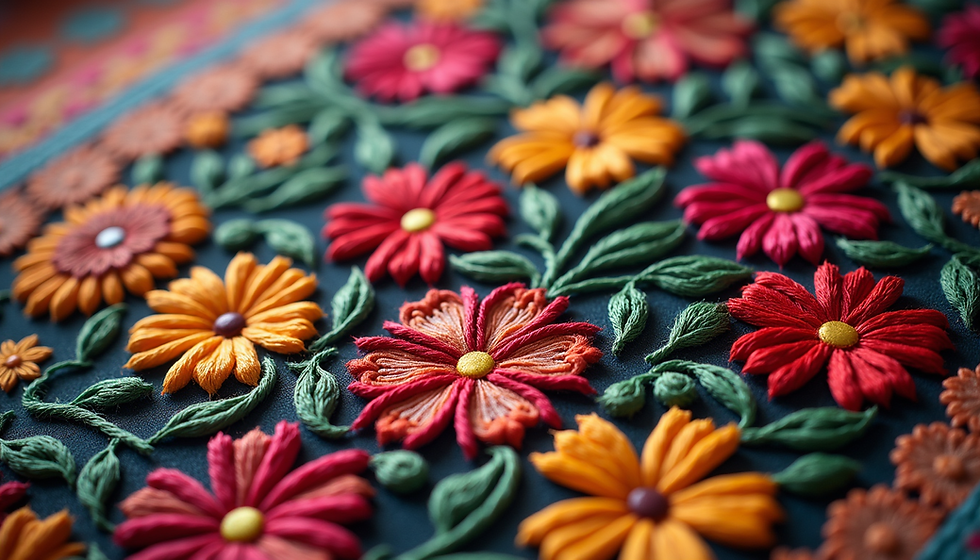- jkartsfoundation
- Aug 20
- 3 min read
Wagoo Mats: Traditional Reed Weaving in Kashmiri Homes

Kashmir, often called "Paradise on Earth," captivates visitors with its stunning scenery and vibrant culture. Among the many crafts that shine in this region, reed weaving—especially the creation of Wagoo mats—is particularly noteworthy. These mats are not just practical items; they embody the skill and creativity of Kashmiri artisans. They also reflect the area's rich heritage and daily life.
The History of Wagoo Mats
The crafting of Wagoo mats has deep roots, tracing back centuries within the cultural landscape of Kashmir. Traditionally, artisans made these mats from reeds that flourish along the banks of local rivers and lakes. Using natural materials emphasizes artisans' connection to the land and their commitment to sustainable practices passed through generations.
Historically, Wagoo mats served multiple purposes. They were common as floor coverings, bedding, and decorative accents. Their adaptability made them staples in Kashmiri households. Over the years, styles and patterns evolved, reflecting the changing tastes and traditions of the community.
The Craftsmanship Behind Wagoo Mats
Creating a Wagoo mat is a detailed and careful process. It requires skill, patience, and a deep respect for the materials. The primary material, "Wagoo" reeds, are harvested at specific times to ensure maximum quality and strength.
Harvesting the Reeds
Artisans begin by harvesting reeds from wetlands, selecting only the finest, sturdy pieces. This handpicking method ensures the reeds are the correct length and thickness. After harvesting, the reeds are cleaned and sun-dried. This crucial drying stage enhances the reeds' durability and prepares them for weaving.
Weaving Techniques
Wagoo mats are crafted using intricate techniques honed over generations. Artisans typically employ a simple loom to weave the reeds together, creating both sturdy and visually appealing mats.
Patterns vary widely, often inspired by Kashmir's natural beauty. Common motifs feature floral designs, geometric shapes, and culturally significant symbols. Each mat carries a narrative, showcasing the artisan’s creativity and the cultural richness of the region.
After weaving, the mats go through a finishing process. Artisans may trim the edges, add decorative elements, or dye the reeds in vibrant colors. The result is a stunning, functional piece of art suitable for various settings in a home.
The Cultural Significance of Wagoo Mats
Wagoo mats play an important role in Kashmiri culture. They symbolize warmth, hospitality, and the rich traditions of the area. In many homes, these mats are central during family gatherings, celebrations, and religious ceremonies, serving as spaces for connecting with loved ones.
Moreover, these mats are often treasured family heirlooms passed down through generations. Each mat holds the stories of those who have used it, becoming an invaluable part of the family legacy.
Wagoo Mats in Modern Kashmiri Homes
Today, Wagoo mats remain significant in modern Kashmiri homes. While they still fulfill their traditional roles, many families appreciate their aesthetic charm and incorporate them into contemporary interior design.
The natural textures and warm colors of Wagoo mats seamlessly blend with various decor styles—from rustic to minimalist. Homeowners enjoy the unique character these mats lend to their spaces, making them popular with both locals and tourists.
The Economic Impact of Wagoo Weaving
Wagoo weaving is both a cultural treasure and a vital source of income for many families in Kashmir. Artisans often work from home, relying on this traditional craft to support their families.
Recently, interest in handmade products has surged, boosting demand for Wagoo mats both locally and globally. This trend has created new opportunities for artisans to showcase their work and connect with a larger audience. For instance, studies show that craft markets have increased foot traffic by over 30% in some areas, leading to higher sales for weavers.
Preserving the Art of Wagoo Weaving
Like many traditional crafts, Wagoo weaving faces modern challenges. Younger people are often drawn to urban lifestyles, losing interest in these time-honored traditions.
To tackle this issue, various organizations and initiatives are working to promote and preserve the craft. Workshops, training programs, and exhibitions educate youth about the significance and skills required to create Wagoo mats. By nurturing pride in this craft, there is hope that Wagoo weaving will continue to flourish for future generations.
Wagoo mats represent more than simple functional items in Kashmiri homes; they reflect the rich cultural heritage and artistry of the region. The detailed craftsmanship involved in creating these mats adds to their historical significance and beauty.
As we celebrate and engage with traditional crafts, it is essential to support the artisans dedicated to preserving these skills. By doing so, we honor their efforts and ensure the artistry of Wagoo mats remains a vibrant part of Kashmiri culture for many years ahead.
In a world dominated by mass production, the handmade quality of Wagoo mats reminds us of the importance of tradition, sustainability, and the personal stories woven into each piece.



Comments